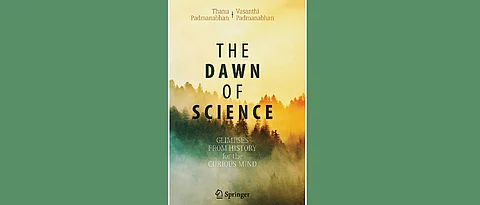

Anyone who would call himself (or herself) a scientist (amateur or otherwise) should certainly have a copy of The Dawn of Science — Glimpses from History for the Curious Mind in his or her library, and read it.
In 24 chapters, the authors, Thanu and Vasanthi Padmanabhan have covered the history of science that is based on recorded information alone. Right in the beginning they make an honest statement that ‘it is never easy to distinguish true science from mythology, magic, and mysticism.’ To churn out the real science from the mumbo-jumbo is at any rate a mammoth task.
Like most writing of this kind, this book too has a box or two in every chapter dealing with a specific topic related to that chapter. In addition, the authors have included two illustrations at the end of a chapter: ‘Where’ gives geographical location of the discovery in discussion and ‘When’ is the vertical pert chart, the timeline.
What is most interesting about reading (and studying) The Dawn of Science... is that the authors spend little or no time on emotional descriptions of the situation they dealt with. The basic fact and importance about an invention or discovery that the authors considered to be the milestone in the history of science, is mentioned and discussed in brief and they move on.
For example – in chapter 11, talking about Copernicus and his first (and last sighting) of his printed book De Revolutionibus Orbium Coelestium, most authors cannot resist describing the emotional drama associated with it. The Padmanabhans summarise the entire episode of publication of this book in just first paragraph that ends with key idea : ‘Copernicus had, in effect, stopped the Sun and set the Earth in motion’. Then they move on to the importance of the discovery of heliocentric world.
The first chapter starts with discussion on Egyptian pyramids, built around 2500 BC. In the box, one finds the note on Egyptian mathematical text (dated 1850 BC) on papyrus which is now in a museum in Moscow.
The authors have also been very objective about their narration of an invention or discovery. One finds very conflicting notes on who first used ‘zero’. In Chapter 7: The Indo-Arabic Numerals gives complete time line of where zero was first used as a mathematical symbol and by whom.
The science of medicine is closest to every human being, directly or indirectly. The evolution of this science (which also is an art) was well dealt in the book. It is worth reading Chapter 5: The Healing Art and Its Science to understand how certain individual have devoted their life to see that their fellow humans live life happily.
The Chapter 21: Story of the Calendar was very fascinating indeed. Time keeping has played a very crucial role in development of every science (from measuring pulse rate to duration of an experiment). This deals with monitoring and recording the passage of time.
The Dawn of Science... concludes at the 18th century as the authors feel that post this period, the history has been well documented. One could always make a criticism that the authors have not given due importance to one discovery or the other. For example I would have preferred if authors had added a paragraph on Julian day — which is a simple continuous count of days free of oddity, uneven days in months used by astronomers to mark celestial events. But I suppose what to include or to give importance to be entirely author’s prerogative.
If ever I plan to give a yearlong course on History of Science, I will use The Dawn of Science Glimpses from History for the Curious Mind as reference book for my first five day introduction to the course.
(The writer is director at Nehru Planetarium Centre, Nehru Centre, Mumbai)
